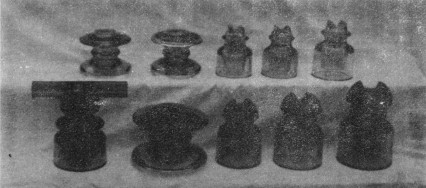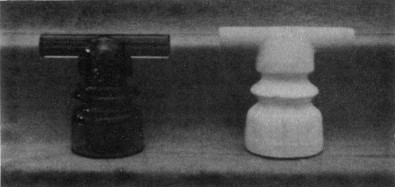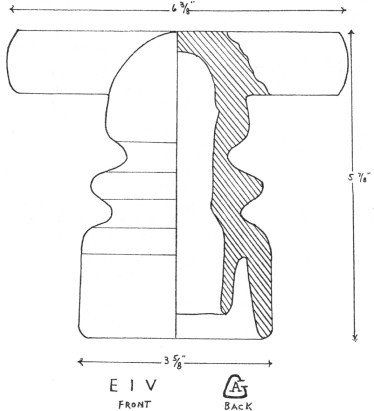Foreign Insulators
by Marilyn Albers
Reprinted from "INSULATORS - Crown Jewels of the Wire", June 1980, page 4
E.I.V. Insulators of France
An insulator buddy said to me
recently, "I enjoy your column, but when are you going to tell a
story?" As I thought this over, I realized how many stories there really
were to tell about my trips to Europe with Father Brock and his student groups.
There was the time in Naples, Italy, when one of the boys imbibed too much wine,
and dangled from the fourth floor balcony of our youth hostel, threatening to
jump because the cutest girl in the group had spurned his advances. Yours truly
was the only chaperone in the building at the time -- everyone else had gone to
see an Italian movie!
Thoughts of Rome bring to mind the overly curious member
of the group who decided to explore an unlit passageway while down in the
catacombs. We didn't miss her until we were back out in the sunshine and ready
to board our bus. After an awful two hours we found her. She was a little pale!
Or maybe you'd like to hear about crossing over the Berlin Wall one evening at
"Check Point Charlie" from the West to the East side to attend a
German opera. After the opera we all rushed back to cross over again at the same
point because the gate closed promptly at 11:00 P.M. My two sons weren't quite
quick enough. They had stopped to look in a store window, so consequently they
spent the night in East Berlin at the police station! We retrieved them the next
morning, but my sigh of relief could be heard rattling windows all over the
city.
So you see, I could go on and on, but this is a column about insulators!
My problem was solved just recently when I was able to add a couple of really
special insulators I didn't have to my French connection - a - collection. They are
embossed E.I.V., which is the same marking as on the ones I was able to find
while in Paris, and of course there is a story involved here, too. But let me
talk insulators for just a bit, or I may never get back to them. Of the fifty
different French glass insulators I have, ten are embossed E.I.V. and are shown
in the photo on the following page.

Top row, left to right:
|
(1) CD 1065 E.I.V. // A-21
|
Small drips on inner skirt. Blue.
|
|
(2) CD 1065 E.I.V. // A-21
|
Smooth base inner skirt. Green
|
|
(3) CD 822 E.I.V. // Dc-2
|
Plastic threaded insert cemented inside Standard American pinhole. Pinhole has bumps instead of
threads. Blue.
|
|
(4) CD 822 E.I.V. // Dc-2
|
Pinhole same size and smooth, no
plastic insert. Greenish
|
|
(5) CD 825 E.I.V. // Dc-3
|
Plastic threaded insert
cemented inside pinhole. Pinhole has bumps, not threads. Blue
|
Bottom row, l. to
r.:
(1) CD ? E.I.V. // A (boxed)
|
Looks to be Standard American size pinhole, threaded.
Remains of metal pin cemented inside. Green.
|
(2) CD 1066 E.I.V. // A22
|
Tiny
drips on inner skirt. Green.
|
(3) CD 833 E.I.V. // Dc-3
|
Smooth pinhole. Green.
|
(4) CD 838 E.I.V. // Hc-64
|
" " Green.
|
(5) CD 839 E.I.V. // Hc-65
|
Large
(1-1/2") threaded pinhole. Green.
|
Grant Salzman (Sacramento, California)
found the largest spool insulator for me at the Chico Show most recently held
March 8-9. I really thank him, because I'm very proud of this one. The large
T-bar may cause some of you to eat your hearts out. I know the feeling -- isn't
that the most beautiful sight you ever saw? Thanks to Pat Patocka (Penryn,
California for his three year long efforts in helping me track down one of
these. It was found in Vietnam, even though it was manufactured in France. Pat
and a non-insulator collector friend (who accompanied him to "Nam")
brought back about six of the glass T-bars. They came from the telephone company
in Saigon and are probably the only ones to have hit this country. Pat sold one
of his and then managed to convince that buyer some years later (and five months
ago) that I wanted the insulator more than he did. At this point I closed in!
The photo below shows the glass T-bar standing next to an unmarked, but almost
identical, porcelain insulator also from Saigon via Pat. He seems to think the
porcelain is a Vietnamese reproduction of the French glass one. It measures a
bit wider and taller, as you can see.


Joe Maurath (now of
Abington, Massachusetts) had such a good report on E.I.V. insulators under
"Research Division" in the January 1977 issue of Crown Jewels, that I
am presenting it again, in case you missed it. He says it better than I could
have.
(The following is in reference to a letter from Ron Witt appearing on page
29 of the October 1976 issue of Crown Jewels.)
Dear Ron,
I read your report of
your E.I.V. insulator in the October 1976 issue of Crown Jewels with interest. I
have some information that I'd like to pass on to you which will shed some light
on its origin.
Your insulator was made by the Saint Gobain Glass Works, Sediver
subsidiary, in Saint Yorre, France. This firm exists today and makes all sorts
of glassware.
The initials E.I.V. represent the words: Societe European
D'Isolateurs en Verre, which translates about as: European Society for Glass
Insulators.
There are numerous E.I.V. pintype insulator styles; some of which
might still be being made today. In Most About Glass Insulators, Third Revision
by Milholland, there are a number of Sediver insulators listed from their 1970
catalog. Depending on the size of your insulator, it is CD #1065, 1066 or 1067,
as you will note in that book.
About ten years ago Sediver exported many
suspension insulators to this country and were used by various utilities. These
green glass insulators were advertised as being more resistant to breakage than
porcelain ones and "three" times the tensile strength of comparable
rated porcelain insulators. These "Toughened Glass Insulators" as they
were called, never became too popular, despite their commendable strength,
because the glass was tempered. If chipped, tension in the glass would release,
violently shattering all of the glass part of the insulator. Since these
insulators commonly were used to insulate power lines carrying substantial
voltages, a shattered unit (or units) would cause trouble. These insulators were
sold in the U.S. by the A. B. Chance Co., Centralia, Missouri. Seven types are
shown in their 1966 brochure; all but one has a 10 or 11-inch diameter disc.
They offered a 7-inch diameter insulator for low voltage distribution.
It is
possible their pintype units also were made from tempered glass, as well as the
insulator you have, which undoubtedly was intended as a secondary rack or
deadening spool.
I hope this information will be of interest to you.
Good
Collecting,
Joe Maurath, Jr.
East Weymouth, Mass.
- - - - - - - - - -
I managed to pick up
several insulators on the 1977 trip to Europe. which included East and West
Germany, Poland, Czechoslovakia. Hungary. Austria, Switzerland, France and
Morocco. But the bulk of my French E.I.V. collection (except the large spool and
the T-bar) I bought while in Paris.
Our stay in Paris, which was near the end of
the month-long trip, lasted four days. Everything you hear about this city is
true -- both the good and not so good! What a fascinating place it is! Our youth
hostel (Auberge de Jeunesse) had an ancient creaky elevator to carry us up and
down its four floors. On one wall of this elevator hung a large mirror -- I'm not
sure why. There was another group of American students staying at the hostel at
the same time, but not related to us in any way. Their behavior was not always
the best (Our group, of course, was perfect.). It might help to add that the
French are not real fond of American tourists, anyhow, period. Now that you have
the picture, I will tell my story:
It was the middle of the night -- 2:00 A.M., in
fact. The students in the other group were scheduled to leave the next day, and
some of their boys were restlessly wandering up and down the halls. They
succeeded in ripping off the elevator mirror and leaving it on the roof! The
proprietor of the hostel was absolutely furious and looked for someone to blame
-- naturally. The other group denied any knowledge of the incident and moved out
-- naturally. So our people were held responsible, and in order to appease an
irate innkeeper, who wanted to oust us, Father Brock "grounded" all 27
of the students. This news was met with great disappointment, because we had one
more day left in Paris, and it had been left free to shop, explore or rest. We'd
done all the duty sight seeing -- museums, cathedrals, parks, art galleries, even
took a boat trip and rode to the top of the Eiffel Tower. The kids were ready to
cut loose for a day and have fun, and I had given a thought or two to finding
some insulators. The owner of the hostel had supplied me, during happier hours,
the address of one of Sediver's electrical supply houses at the other end of the
city. Father Brock finally agreed to let each chaperone take up to three
students and still go shopping or whatever. Upon hearing this, I latched on to
three of our biggest boys. "Look," I said, "You're coming with
me!" And the four of us rode the subway (Metro) to ETS PERTUS, MATERIAL
ELECTRIQUE, 11 & 13 Rue des Arquebusiers. All the way there, through four
subway stops and changes, I out-shouted those three boys, finally convincing
them that if they would go with me to find insulators, I would then go along
with them to do what they wanted. We arrived at our destination at 12:00 noon,
just as the store was closing, which the storekeeper informed us it did every
day and remained so until 2:00 P.M. "Come back then," he said through
a small crack in the door. "Oh, but we can't!" I objected. He finally
relented and let us in, but he was extremely suspicious that we were up to no
good, and in his faltering English asked what we wanted. When I told him, he was
sure he'd heard me wrong, so I repeated my answer. You know the rest -- slow
smile -- look of utter disbelief -- and finally he let out a loud guffaw (how
humiliating!).
He shouted a few orders in French to the other employees
who had begun to gather close to listen. Each trip from the back room produced
another insulator and another laugh. We had almost (almost) more than we could
carry. Some, of course, were duplicates, but all were E.I.V. and mint glass! I
paid a relatively modest sum for the whole lot and received a bill of sale for
customs. The trip back to the hostel by Metro was both amusing and treacherous.
Have you ever tried to hang on to the overhead strap of a crowded subway with a
couple of insulators in each hand, and all your pockets are full, too? Now
multiply that by four. And oh, the stares! The boys were so embarrassed. I was,
too, but it was worth it. We left the insulators at the hostel then and spent
the rest of the afternoon poking around through Paris' Left Bank with its
Bohemian life-style and lower prices -- certainly much more student-oriented than
the very fashionable and proper and more expensive Right Bank.
The following
day, the mirror had been replaced in the elevator and our very full plane took
off for Casablanca, Morocco, with twenty-seven students, ten chaperones, the
remaining passengers, tons of souvenirs and my insulators. I thought I heard a
familiar voice coming from somewhere at the back of the plane. It said between
clenched teeth, "Up, insulators, up!"
Morocco proved to be a
fascinating place, but that is another story ......
Are you still wondering what
happened to the boy on the fourth floor balcony in Naples? The movie ended,
Father Brock and the others came back to the hostel just in time. One of the
other boys crawled out on a ledge next to the balcony, grabbed hold of the
unhappy youth and pulled him back to safety. This still gives me goose bumps
just thinking about it. The incident brought out the best in every one of those
kids -- they all let him know they loved him, and he was not left alone
a minute
for the rest of the trip.
|
